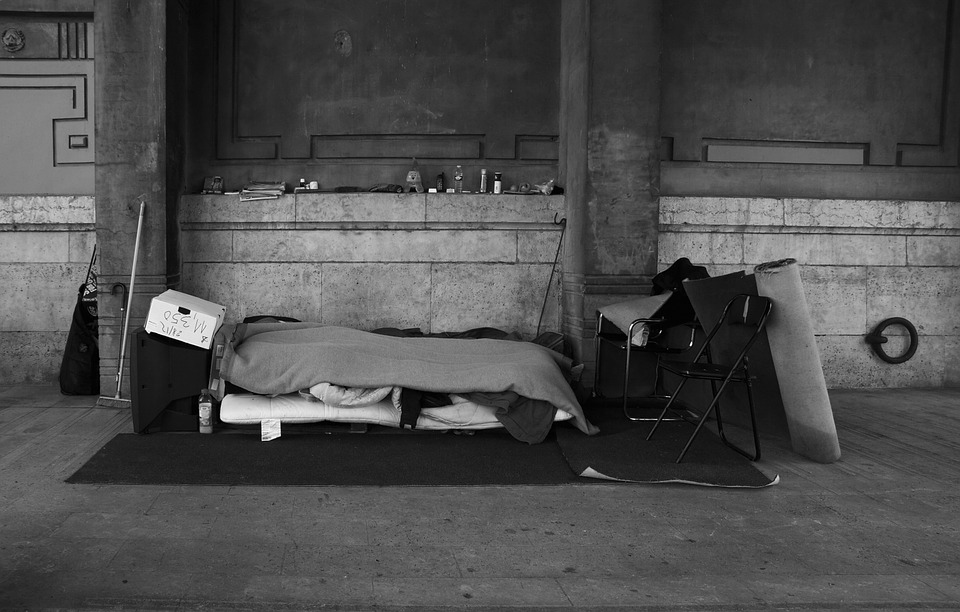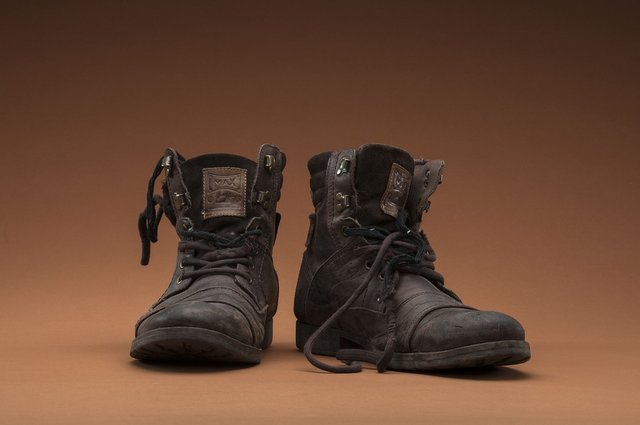
”The hobo lifestyle is a curious thing to celebrate, but it speaks to something quintessentially American — a spirit of rebellious independence, hardscrabble survival and the hope of something better a little further down the line.”
There is a bitter chill to the early winter wind which skips and skates across the river. With teeth chattering, fingers numb and huddled in the confines of his cardboard shanty, he hacks out the final bits and pieces of code on the cracked screen of his smartphone to a cloud server in Hong Kong. With a few last keystrokes, his cloud server now begins to mine cryptocurrency. It provides him a small stream of digital tokens each day, which he can trade for cash at one of several exchanges on the internet. It provides a minimum necessary income to subsist and a small measure of freedom to focus on something else. The first order of business once the trades finalize is to fix the broken screen of his smartphone and finish hacking his next web application.
Once upon a time, a Hobo hit the rails in search of work in the post-Civil War rebuilding effort. In the digital age, Hobos have started to replace their shovels with smartphones, laptops and digital cameras. A new romance has blossomed with the Hobos of the digital age, spawning Hobo social media superstars amassing subscriber bases in the thousands. They can reap ad revenue sharing deals with Youtube . They may also utilize platforms such as Bitshares to create innovative financial derivative products on a blockchain-driven decentralized exchange, leverage Ebay to create a virtual storefront from their car or shelter, or develop a novel carbon-cutting, ride sharing web application embodying the phrase, “shoestring startup.”
It’s a Brave New World.
Welcome to the subculture of the Modern Hobo.
History of Hobos in America

There is no distinct moment signaling when the Hobo subculture began. It is widely believed to have first appeared during the 1860’s American Railroad scene, as many discharged Civil War veterans returned home by hopping freight trains. Post Civil War America was a war-torn wasteland, and the veteran soldiers from both sides grabbed a hoe or shovel and hit the rails in search of work during the rebuilding effort. Hoboes were instrumental in the construction of the very transcontinental railways they used for travel, in addition to the sewer systems, water lines, roads, bridges and homes which filled out the American West. Migrating from place to place, they worked hard, earned money, used it to move to the next location and looked for more work. This was the genesis of the Hobo subculture. In fact, the etymology of the word “hobo” is believed to be a syllabic abbreviation of either the phrase “homeward bound” or the phrase “homeless boy.”
In the 1930s, the Hobo ranks swelled to an estimated 4 million adults, and 250,000 teenagers as the combination of the Great Depression and the Dust Bowl wreaked havoc on society. Hitting the rails in search of work and wages was a common and acceptable way for the working man to get around, and sources from Hard Times recalled, "when a train would stop in a small town, and the bums got off, the population would triple."
While romanticized in American culture and lore, life as a Hobo was very harsh. Bulls (railroad police) were hired to keep Hoboes from freight hopping and frequently used intimidation and violence (clubbing and shooting) at both ends of freight hops during the depression era. Hoboes were also targeted by authorities and agents in cities and towns, believing all transients to have mischievous intent. In fact, Jack London, author of The Call of the Wild and White Fang, famously ended up serving 30 days in jail for vagrancy after train hopping his way to Niagara Falls in the 1890s.
The Hobo Code is a system of cryptic symbols, which was developed in the 1850’s. It was used by the Hobo “brotherhood” to communicate with one another and continues to be actively employed by the Hobo community today. It was a unique language of symbols which was understood by the Brotherhood and allowed the community to communicate where to find shelter, food, work and remain safe. These signs and glyphs were scrawled on fence posts and train crossings to share information and help fellow Hobos.
As the United States economy rose from the depths of the Great Depression, widespread prosperity was experienced by all. Consequently, automobile ownership and home ownership grew at a frenetic pace and this kept the population ensconced in their homes, and in the leisure of road trips. These cultural shifts heralded both the apex and the death-knell of the golden era for Hobo subculture.
The Great Recession of 2008 caused a tsunami of home foreclosures, abruptly displacing thousands of families into the world of homelessness in the digital age. In this age, there were no massive public works projects, road crews or infusion of cash into the hands of the masses. In this brave, new, digitized, interconnected world, saturated with smartphones and data plans, technology forced us to experience loss and homelessness in a new way. No longer were stories told through the lens of magazine photographers and journalists. Social media feeds shone a bright spotlight through friends, family, and people within our social networks experiencing homelessness firsthand. It provided a method to organize and protest on a much larger scale; such as with the Occupy Movement. Crowdfunding campaigns across platforms such as GoFundMe replaced the soup kitchen lines photographed almost a century ago.
The impact to the hobo community was significant. For the first time in half a century, the ranks of the hobo community began to swell. As the young and technologically adept found themselves enmeshed in these communities, the confluence of cheap cellular phones, more affordable data and a critical saturation of social media has both breathed new life into this subculture and morphed the subculture in new ways. Glyphs and signs scrawled on the fence post, and train crossings gave way to mobile device optimized websites and web applications. Squatters using smartphones connect to the internet and learn how to bring amenities such as electricity and running water to the neglected structures they occupy and improve. Social media sites allow hobo jungles to control the messaging about their community to the larger world in a way never before available.
Technology appears to be forcing a broad cultural shift in the world of the Modern Hobo.
Modern Web Applications and the Hobo v 2.0

While the original Hobo Code remains intact, it can be argued the rise of the digital age has created the Hobo Code v2. Obscure symbolic glyphs have given way to programming languages and web applications. A cloud-based, connected age, combined with an influx of young technophiles gave rise to web applications developed by tech savvy Hobos to address needs unique to Hobos and the homeless.
Train Hopping, Hitchhiking and Free Wifi Location Websites and Web Applications
HitchWiki is a crowdsourced website devoted to gathering information for hitchhiking and cheap forms of transportation all over the world. However, if you’d prefer to experience train hopping in the more traditional sense, On-Track-Online is the definitive resource for Modern Hoboes. Replete with train schedules, AAR Radio Frequency channels, forums and everything you need to know for your train hopping excursion.
With data minutes at a premium, WiFi Free Spot is an essential resource no Modern Hobo can afford to be without. It provides an extensive, crowdsourced list of places throughout the continental US which offer free WiFi hotspots.
Squatting, Freegan Resources and Social Network Websites and Web Applications
Squat the Planet taglines itself as an online community of misfit travelers, but has grown to become the Reddit of the Hobo and Vagabond community; encompassing the entertainment, social and resource hub of the larger Hobo community. Another major social hub and community web application is Northbank Fred’s website. It’s loaded with stories, photographs, articles, and online resource links.
In the event, one might foresee dumpster diving in the foreseeable future, TrashWiki has crowdsourced the knowledge of the Hobo and homeless community across the globe. In 855 articles, one can learn how to glean value from trash and how to use recycled waste products from dumpsters to live for free.
Cryptocurrencies and Solutions for the Unbanked
Technology has disproportionately impacted one major hurdle of a Modern Hobo’s life more than any other – being unbanked.
Many areas of the world, especially in sub-Sahara Africa, lack the core banking infrastructure (brick and mortar bank branches, ATMs, etc.) to service the larger population. In 2007, Vodafone launched M-PESA, a mobile phone, SMS-based money transfer platform through Safaricom and Vodacom in Kenya and Tanzania. The service allowed users to deposit, withdrawal, transfer money and pay for goods and services via SMS text messages, eliminating the need for banks. Users flocked to the service in such large numbers, by 2015 M-PESA expanded into Afghanistan, South Africa, India, Romania, and Albania and as of June 2016, M-Pesa had 25 million users in Just Kenya and Tanzania alone.
In a similar vein, cryptocurrencies and blockchain technology have afforded Modern Hobos solutions for the challenge of being unbanked which are similar, and in some ways superior, to M-PESA. Cryptocurrencies such as Bitcoin, allow a peer to peer transfers of value (as a digital token) across a distributed network, without the need for a bank. They also support a digital wallet to store those tokens – much like a digital piggy bank. A host of products and services can be purchased with Bitcoin, eliminating the need for a bank or financial institution to behave as an intermediary. For instance, gift cards can be purchased from most retailers and restaurants (Walmart, Target, Kroger, Cabelas Sporting Goods, Starbucks, etc.). Prepaid debit cards have come to the cryptocurrency market as well (both virtual and physical), permitting transactions which may require credit cards (hotel reservations, paying cellular phone bills, etc.). On the off chance, one would still need cash, a small network of Bitcoin ATMs exist throughout the United States, most providing two-way transactions (purchase of Bitcoin and sale of Bitcoin for immediate cash).
Cloud mining companies, such as Genesis Mining, lease cloud-based servers in Hong Kong to mine cryptocurrencies such as Bitcoin, Litecoin, Ethereum, and Dash. As the server solves increasingly more complex cryptographic puzzles, it can provide a modest stream of digital tokens, which may be traded on various exchanges located worldwide. These can allow access to a minimum basic income for the Modern Hobo which did not exist before, without the requirement of a physical location to house the server.
Steemit , a blockchain based social network, has evolved the concept of the social network to include empowering the community to award rewards in the tradable cryptocurrency STEEM, in exchange for developing content the greater community values and upvotes. Steemit has created an avenue for Modern Hobos and homeless to monetize their social content instead of posting for free on Facebook, Youtube or other social media sites.
The Modern Hobo and the Cultural Shift

The infusion of technology in a general sense, but social media more specifically, has dramatically impacted the Hobo subculture like the widespread prosperity post-Depression era. While very similar in breadth, the result is drastically different.
With the rise of social media, came the rise of social influencers – individuals with huge, passionate subscriber bases on social media platforms, and who strongly influence their customer actions and purchasing habits. The irony of all ironies, this trend gave rise to social influencers in the Hobo community as well, with subscriber bases in the thousands.
Significant Hobo Social Influencers
Nomadic Fanatic, a full-time rubber tramp, travels the US with his cat and has a subscriber base of 102,000 and growing. He features videos of his full-time nomadic lifestyle and has partnered with Youtube in an ad revenue sharing deal.
Hobo Stobe, a self-described Hobo, records mega-adventures and train hopping excursions for his subscriber base of 3,699 on Youtube and additional customers on Patreon. His subscribers fund the trips he films and provide him with his gear.
In the oddest of twists, social media and the age of reality television not only allowed Modern Hoboes a voice where the opportunity never existed before but has, in fact, created bonafide social media stars and mainstream influencers.
Technology is rekindling an old romance with the American Hobo.
The American Hobo is a subculture in transition courtesy of the confluence of the digital age, an American economy which has been unforgiving and an almost limitless pool of online resources. The Modern Hobo subculture is growing both by individuals who choose the vagabond life and those who have succumbed to the homeless ranks. Technology permits a life within this subculture which was not possible before. In the words of a vagabond:
“I’ve found a way to be homeless without starving or begging or sleeping in ditches,” he says. “I’ve become a professional vagabond, and this is the lifestyle that I love.”
Originally Published at Medium.com on June 4, 2017
Thank you for posting this, a super well written piece!
Downvoting a post can decrease pending rewards and make it less visible. Common reasons:
Submit
I never even thought about this. Thanks for sharing. Also very cool to see people moving to youtube and steemit to record their travels :)
Downvoting a post can decrease pending rewards and make it less visible. Common reasons:
Submit
Very interesting post and a good read. Thanks for sharing.
Downvoting a post can decrease pending rewards and make it less visible. Common reasons:
Submit
Wawwww amazing my man
Downvoting a post can decrease pending rewards and make it less visible. Common reasons:
Submit
@joe28 thanks for taking the time to read and comment. I appreciate it.
I started doing a whole series on Subcultures here a while back and I took a bit of a break from it. One of the subcultures I covered earlier was the Modern Hobo, but I always felt like I had cut too much out of the story in the edit phase, so it always felt incomplete. Even with this revisit, I have a ton I had to leave out, otherwise it would have become a chapter in a book.
At some point, I will tell a much deeper, more complete story in the book I am writing.
Glad you enjoyed the piece.
Downvoting a post can decrease pending rewards and make it less visible. Common reasons:
Submit
You are welcome brother.
Lets enjoy my post too brother.
Downvoting a post can decrease pending rewards and make it less visible. Common reasons:
Submit
Way cool, I'm liking game changing Hobo 2.0.
Please share more of this amazing content.
Downvoting a post can decrease pending rewards and make it less visible. Common reasons:
Submit
@bilbop thanks for taking the time to read and comment. I appreciate the interaction.
I have about another four or five pieces in the works right now along with two other projects which I've been working on. Looking forward to share some more in the near future.
I'm glad you enjoyed the piece.
Downvoting a post can decrease pending rewards and make it less visible. Common reasons:
Submit
You're welcome. I am fascinated with the hobo stories.
I had friends years ago who we're hippies who rode the rails with stories of adventure and intrigue.
I await more of your pieces.
Downvoting a post can decrease pending rewards and make it less visible. Common reasons:
Submit
Downvoting a post can decrease pending rewards and make it less visible. Common reasons:
Submit
Thanks for taking the time to read and coment.
There is something alluring about the freedom. It's why Hoboism is romanticized and even has it's own museum and summer festival in Britt, IA. I have so much more material on modern hobos which I edited out for this piece. At some point I imagine it will either make its way here or to a future book.
Downvoting a post can decrease pending rewards and make it less visible. Common reasons:
Submit
This post received a 12% upvote from @randowhale thanks to @lpfaust! For more information, click here!
Downvoting a post can decrease pending rewards and make it less visible. Common reasons:
Submit
RIP HOBO Stobe......... the Great Stobe Attack .....
Live be4u Die
Downvoting a post can decrease pending rewards and make it less visible. Common reasons:
Submit
Hi! Have you heard about @krwhale? It is similiar with @randowhale. For your information please click on.
Downvoting a post can decrease pending rewards and make it less visible. Common reasons:
Submit